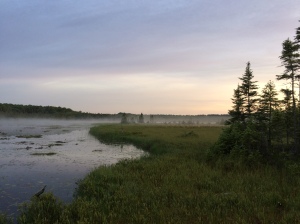Monday marked the longest day of the year in Chicago, and this year it is especially gorgeous with the full moon occurring alongside it. Last time we had such an astronomical occurrence was 70 years ago, literally a once in a lifetime event.
And I spent it recuperating and baking.

Wild strawberries for the Strawberry Moon
You see, elaborate rituals are not my forte, and the past weekend was my actual celebration outdoors with observing the dance of the Sun and Moon in the sky, even if those days were not precisely the solstice. I had a wonderful last-minute opportunity to join friends from grad school at the Chequamegon-Nicolet National Forest of Northern Wisconsin for a bird survey, a 30-year-old event that occurred every June. This year it happened to occur right by the solstice instead of early June, and I adapted my planned celebration to take advantage of the trip (I’m an ecologist by trade but birding is more of a hobby).

The question is, are we the dorks or are the birds?
Saturday I woke at 3am to the serene quiet of a forest under a bright, nearly full moon (the sliver that was left to go was indiscernible). We were a group of roughly 30 people staying in small, lodge-like headquarters in a nature center and not a single sound of human civilization could be heard beyond ourselves. We quietly and quickly got ready and ate breakfast, embarking on a 45 minute trip to our designated sites scattered around the Eagle River-Florence forest sections. We had roughly 100 sq miles to ourselves for both days.

Around 4:30 am we reached our first site, my favorite one, and immediately a wave of peace washed over me. I had not been well lately, poor sleeping patterns and all, and the night before was no exception. But all of a sudden I felt the healthiest I had been in a while, and nothing was bothering me. My head was clear and my body was pain-free. The bog was one of the most beautiful places I had ever seen, and pictures could not do it justice. The other sites were the same way, each one filling me with awe at their beauty and unique energies that you just can’t get at a local park or a backyard.

The bog on “Grandma’s Lake”
We started the bird call survey (otherwise known as point counts) before the sun rose, so we were able to watch her rise and spread her warmth to the land as we worked. The bird calls increased in strength and frequency during those early hours, as if to also celebrate her return. The sky was clear and the temperatures were perfect for my cold-loving self.

I basked in her warmth as the morning went on, but soon the birds died down and I too felt exhaustion come over me as she rose high in the sky for her noon debut. The survey was complete for the day and I went inside the lodge for a much-needed nap. I woke again at 5:30pm and joined the others for dinner and a bit of socializing. I caught up with friends I hadn’t seen for a couple of years and met new folks with a similar love for nature and nerd jokes. It was nice to be among a group that I could relax and participate in conversations with.

Iris versicolor (Northern Blue Flag)
At about 8:30pm we gathered in a conference room to exchange our experiences for the day and discuss the results of almost 30 years of survey work, available for free by the US Forest Service. During the presentation of the data I was reminded of why I do this work, and why it is necessary. We are dependent upon the land for our lives, not just our livelihoods, and for the past several hundred years we have done nothing but exploit and poison it. The landwihts have been ignored and downright disrespected, their homes destroyed and taken over by us. My work as an ecologist and as a heathen is to help restore right relationships between humans, the land, and the wihts, to recover what I can of what was lost.

During the meeting it was shown that bird populations had improved for most birds over those 30 years, likely due to more sensitive logging practices implemented a few years beforehand that left more habitat alone to provide maturing trees for the species that required them. It suggests that a balance between the industry and the forest was able to occur, a balance which is sorely needed in most other places. I too was in need of balance, and what better time to start restoring it than during the solstice?

After the meeting I went down to the river dock to watch the sun set and contemplate the weekend’s many gifts. A fire burned nearby, a light breeze wafting the spicy scent of burning wood by me. Dragonflies hummed over the water and the calls of the birds we surveyed earlier were dying down again as they settled in for the night. Soon I could see a full moon rise over the tree tops, illuminating the forest below it with her dim light. I knew I wasn’t going to fall asleep in time before Sunday’s 3am start so I just stayed awake and experienced the night. A raccoon joined me, scouring the center field for insects and worms to munch on.

Where the conference magic happens
The fieldwork on Sunday was just as fantastic to experience as Saturday despite my lack of sleep, and went by much quicker too as the sites were closer to each other. Csodaszarvas carried the sun beautifully through the sky and I gave brief praise to Her and Napkirály. Then it was time to end the survey for the year and drive back home.

Polyphemus moth (Antheraea polyphemus)
Due to the large amount of physical strain and sleep debt I had to spend the actual solstice recovering from the weekend and avoiding most work. I’m not able to quickly bounce back from a trip like that anymore, and part of restoring balance to oneself is allowing time for rest. I am grateful that I am able to rest without losing pay or other negative consequences. All I had to do was clean the kitchen to bake apple muffins, the closest I’m going to get to making a bonfire and throwing apples into it.

yes, they were delicious
I am enjoying my newfound adherence to the holidays, and I’m finally starting to understand how important they can be in structuring one’s life and bringing us closer to the land. Next year I can watch the sun rise over Lake Michigan, which I had originally planned to do today, and then watch it set to complete the day. Maybe make an actual fire from the bones of my enemies and throw some apples into it. Now the real question is, Macintosh or Red Delicious?








